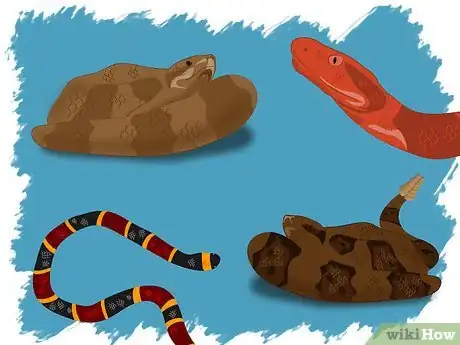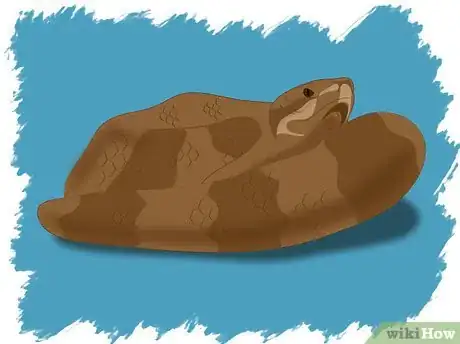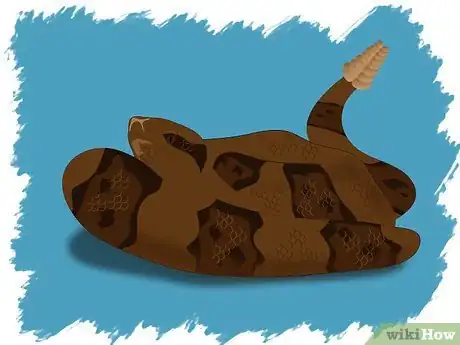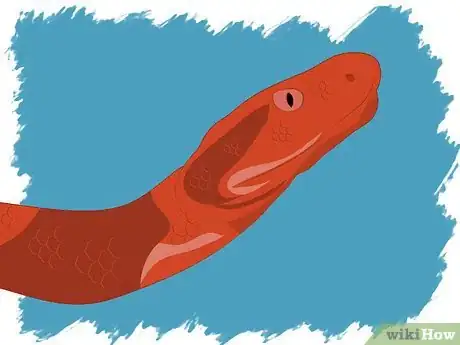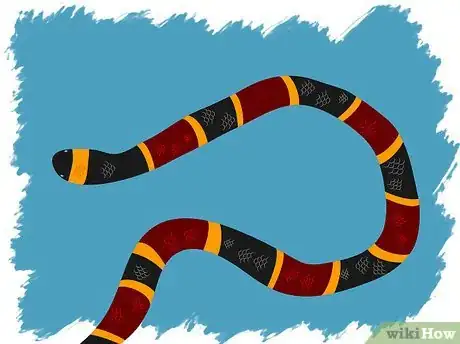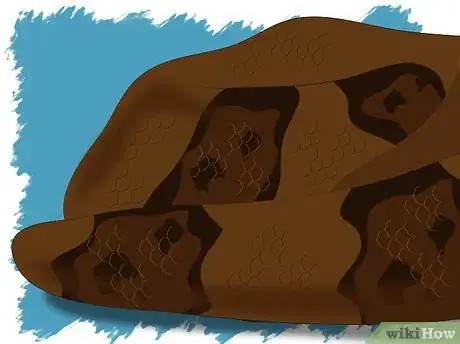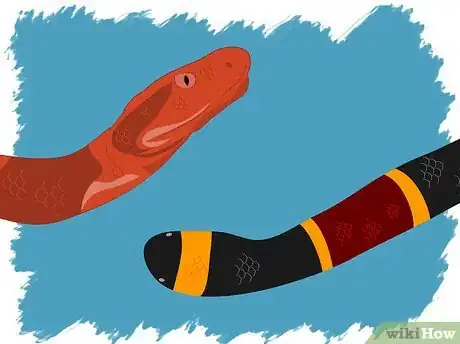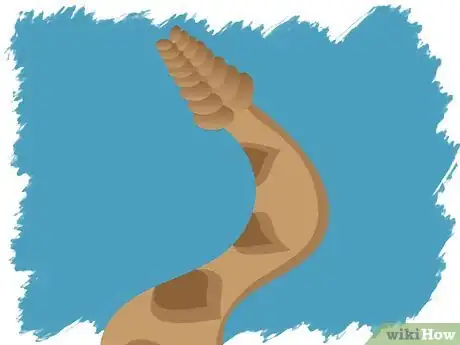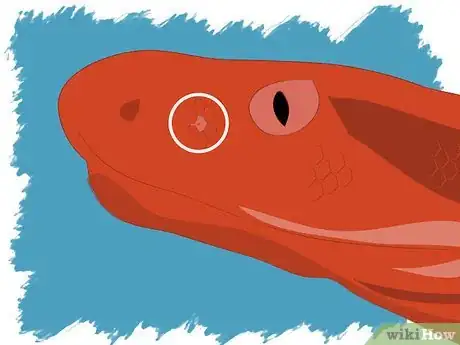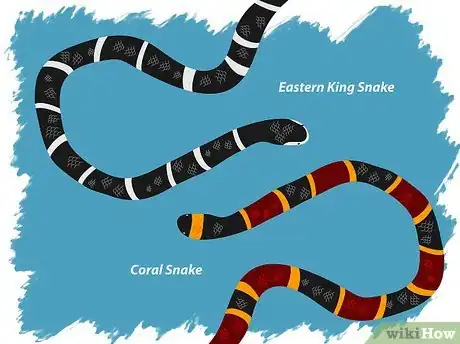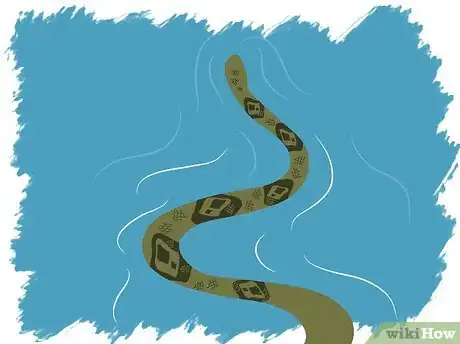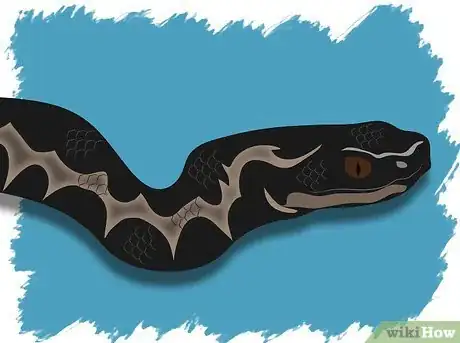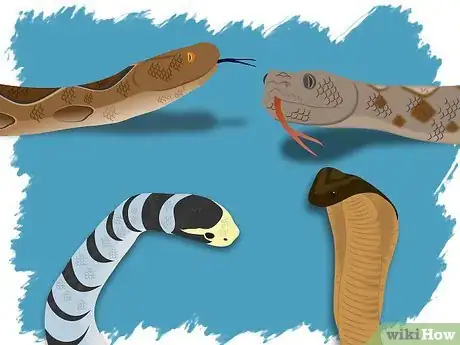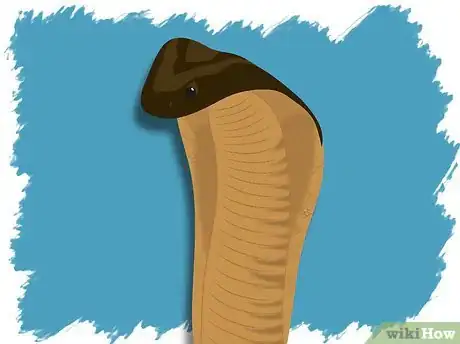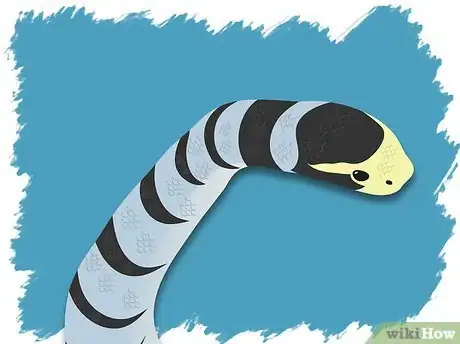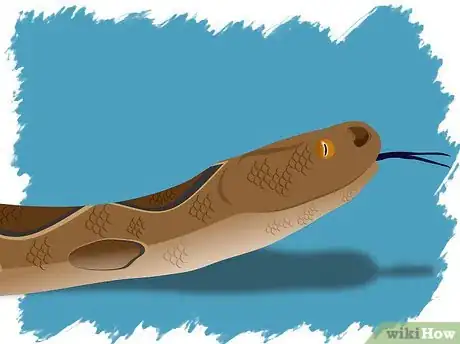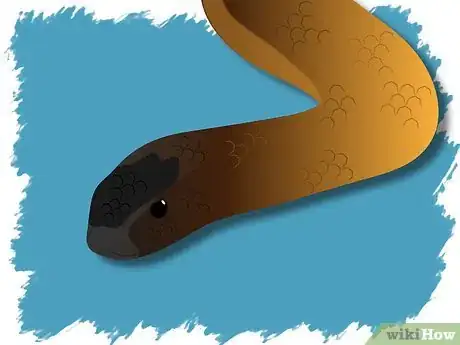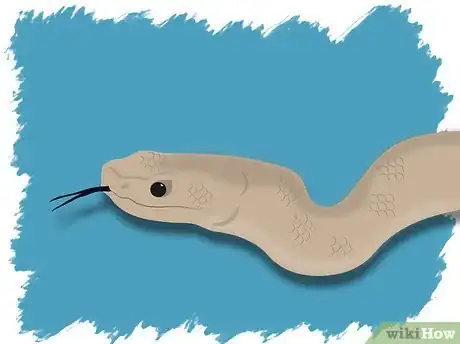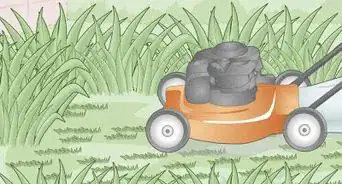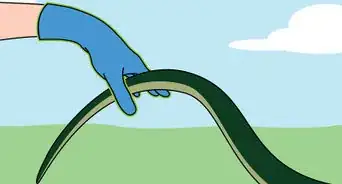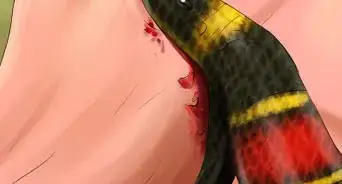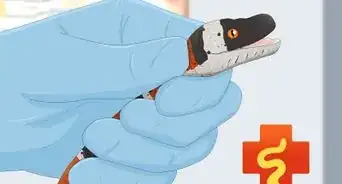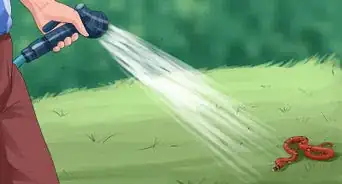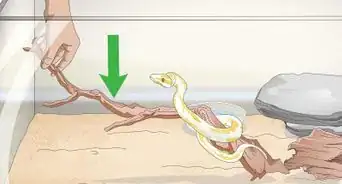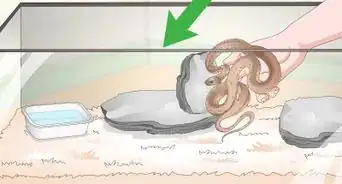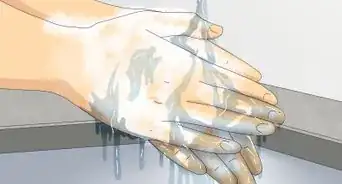wikiHow is a “wiki,” similar to Wikipedia, which means that many of our articles are co-written by multiple authors. To create this article, 102 people, some anonymous, worked to edit and improve it over time.
There are 13 references cited in this article, which can be found at the bottom of the page.
This article has been viewed 1,508,401 times.
Learn more...
Snakes have captured our imagination—and fear—for as long as we've shared the planet together. They are the stuff of legend. While less than one third of all snake species are venomous (unless you live in Australia, where that number is 65%!), it's good to know what to look out for. Be careful around all snakes—but non venomous snake bites aren't painful; they feel like a pinprick.
Steps
Identifying Venomous North American Snakes
-
1Know the snakes. There are four different types of venomous snakes in the United States: cottonmouths, rattlesnakes, copperheads and coral snakes.
- Cottonmouths. The cottonmouths have elliptical pupils and range in color from black to green. They have a white stripe along the side of their heads. They are often found in or around water, but have also adapted to live well on land. Young snakes have a bright yellow tail. They are often loners, so if you see multiple snakes coexisting peacefully, it is probably not a cottonmouth.[1]
- Rattlesnakes. Look for the rattle on the tail. Some harmless snakes imitate the rattle by brushing their tails through leaves, but only rattle snakes have the button-like rattle at the end of the tail. If you can't see the rattle, they also have a heavy triangular head and elliptical eyes like a cat's.[2]
- Copperheads. These beauties have a similar body shape to cottonmouths but are much brighter, ranging from coppery brown to bright orange, silver-pink and peach. The young have yellow tails as well.[3]
- Coral snakes. Another beautiful but deadly snake is the Coral snake—so beautiful that other snakes—not-venomous ones such as the Milk snake—look just like them. They have distinctive coloring, though, with a black, yellow and red bands, a yellow head, and a black band over their nose. One rhyme to help distinguish coral snakes from king snakes is 'Red to yellow, kill a fellow. Red to black, friend of Jack.' Another variation is 'Red on black, venom lack; red on yellow, deadly fellow'. However, most of the time coral snakes will not bite - they are very shy. There are no known deaths from the Arizona coral snake and only a few from the Eastern Coral snake.[4]
-
2Look at the color patterns. Venomous Snakes in the U.S. tend to have varying colors. Most snakes that are one solid color are completely harmless. However, cottonmouths are also venomous so this is not a foolproof way to tell them apart. Also, beware of venomous escaped pets.Advertisement
-
3Check out their head shape. Non-venomous snakes have a spoon-shaped rounded head and venomous snakes will have a more triangular head. this is because of the venom glands (this is less noticeable on the coral snake).
-
4Look for a rattle. If the snake has a rattle on its tail it is a rattlesnake, and therefore venomous. However, some non-venomous snakes do mimic the rattle by rattling their tails, but lack the rattle "buttons" that sound like little salt shakers.[5]
-
5Look for the heat sensor. Some venomous snakes in the U.S. will have a small depression between the eye and the nostril. This is called a pit (hence "pit viper"), which is used by the snake to sense heat in their prey. Coral snakes are not pit vipers, and lack this feature.[6]
-
6Watch out for mimics. Some non-venomous snakes mimic the patterns and behaviors of venomous snakes. Rat snakes can look like Rattlers, and harmless Milk and King snakes can look like Coral snakes.
- Always treat any snake as a venomous snake if you are uncertain whether it is venomous or non-venomous. And though you should remain cautious, do not kill any snake—it could be illegal to do so, and killing non-venomous snakes allows venomous snake and vermin populations to grow.[7]
-
7Identify the Water Moccasin (aka Cottonmouth) This snake will have elliptical pupils and the harmless water snake will have round pupils. Either way, leave it alone and allow it to leave the area.
Identify the Deadliest Snakes in the World in Australia
-
1Beware of the Fierce Snake. AKA the Inland Taipan, the Fierce Snake has the reputation of being the most deadly snake on the planet. Its venom is more potent than any other species by far, and yet—there's no record of a human fatality caused by the Fierce Snake.
- This bad boy can reach a length of over 6 feet (1.8 m), and varies in color from dark brown to a light straw. It's darker in the winter than it is in the summer. It's head can appear almost black.[12]
- It lives in the black soil plains where Queensland, South Australia, and the Northern Territory borders meet.
-
2Avoid the Eastern Brown Snake. Unlike the most venomous snake, the Inland Taipan, the Eastern Brown Snake is responsible for the most snakebite deaths in Australia. Like all snakes, they would much rather slither away than attack, but if they are threatened, or grabbed, or stepped on, all bets are off.[13] .
- They can exceed 6 feet (2m) in length, and are very fast—especially on hot days. They're slender, with a variable color ranging from tan to gray or dark brown. Their belly is lighter, and has darker orange spots.
- They inhabit eastern Australia, from the desert to the coast, and prefer open grasslands, pastures, and woodland.
- Needless to say, if you're bitten by one of these snakes, get help immediately!
Warnings
- Looking at a snakes eyes is not a valid way to identify if it is venomous or not. Cobras, Black Mamba's and other types of very venomous snakes have round pupils, while red tailed boas, emerald tree boas and green tree pythons have elliptical eyes. Do not approach an unknown snake just because it has round pupils, it does not mean it is not venomous.⧼thumbs_response⧽
- Some snakes that look like they are non-venomous may be venomous or the other way around. Make sure you know the kinds of snakes in your area.⧼thumbs_response⧽
- Many venomous snakes are now critically endangered or threatened in the United States. It is against federal law to kill or interfere with any endangered species, and that includes protected venomous snakes. In addition, in many states it is illegal to kill, capture, harass, or possess wild snakes of any sort, venomous or non-venomous.⧼thumbs_response⧽
- Do not harass a snake or get extra-close to it to try to identify it, unless you are already sure it is not venomous. Most snakes would prefer to avoid you.⧼thumbs_response⧽
References
- ↑ https://sciencing.com/identify-cottonmouth-snake-2285255.html
- ↑ https://www.livescience.com/43683-rattlesnake.html
- ↑ https://sciencing.com/identify-copperhead-4549967.html
- ↑ https://www.livescience.com/43938-coral-snakes-colors-bites-farts-facts.html
- ↑ http://www.wildlife-removal.com/snakepoisonous.html
- ↑ http://www.wildlife-removal.com/snakepoisonous.html
- ↑ https://myfwc.com/conservation/you-conserve/wildlife/snakes/
- ↑ http://toxicology.ucsd.edu/Snakebite%20Protocols/Naja2.htm
- ↑ https://snake-facts.weebly.com/common-krait.html
- ↑ https://snake-facts.weebly.com/russells-viper.html
- ↑ https://jlrexplore.com/explore/from-the-field/snakebite-prevention-and-treatment-2
- ↑ https://australianmuseum.net.au/learn/animals/reptiles/inland-taipan/
- ↑ https://www.qm.qld.gov.au/find+out+about/animals+of+queensland/reptiles/snakes/common+and+dangerous+species/eastern+brown+snake#.XMM0y-gzZPY
- http://www.herpetofauna.co.uk/adder.htm
About This Article
To identify a venomous snake in the U.S., look for varying color patterns, since most solid-colored are harmless. Next, check for a triangular head shape, since non-venomous snakes have rounded heads. If the snake has a rattle on its tail, it is a venomous rattlesnake! You can also look for the heat sensor, which is a small depression between the eye and the nostril, to identify a poisonous snake. Always treat any snake as venomous if you can't identify it! For tips on identifying poisonous snakes in the UK, India, and Australia, read on!
